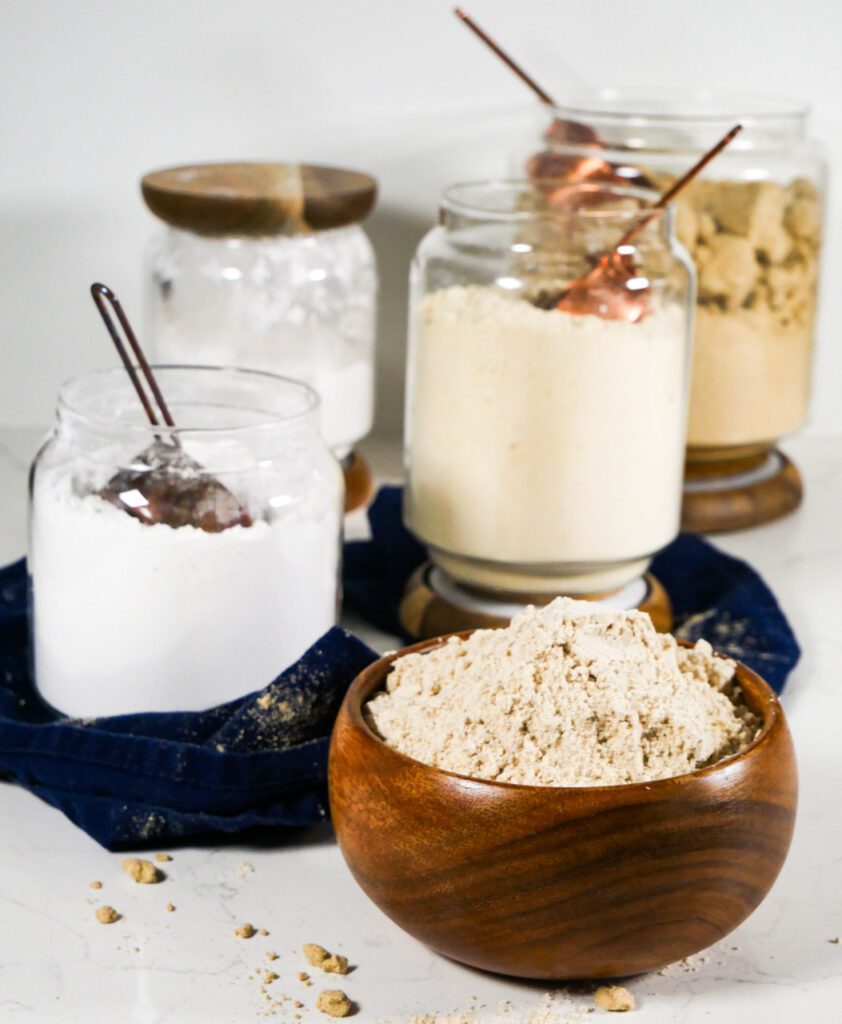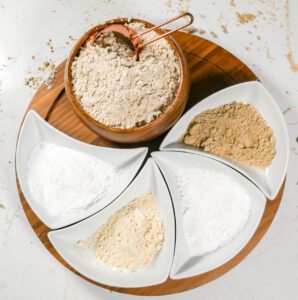Gluten, grain, and nut-free all-purpose DIY Flour blend
This all-purpose blend is by far the easiest recipe with so much versatility when it comes to cooking. It’s been hard to find a flour blend that’s not only gluten-free but grain-free and nut-free to serve everyone in our family. There’s nothing better than watching the folks around you who have so many allergies (and those who don’t) all eat the same thing without worry. Go ahead and have that muffin, cake or bread with this flour blend. We promise this won’t make you miss wheat-based recipes.
Gluten-free flours are more complicated than their non-allergen counterparts. Just one flour type is not enough to help you achieve the desired textures and consistency. You’ve probably noticed that when you use just one, you end up with a really gummy consistency that can take forever to bake in the oven.
It’s so disheartening when that feel-good recipe you were excited about comes out with a deceivingly well-formed top and then a crumbly interior you weren’t exactly looking for. It can feel like you’re wasting away costly ingredients and precious time.
We’re here to help save the day. Let’s dig into why the blend is a must. This will help you along the way as you experiment with baking your own recipes or cooking one of ours!
what you need to know about flours
America’s Test Kitchen offers a great explanation of what gluten does. Wheat flour is formed from wheat berries containing starches and proteins, such as gluten. Gluten combined with other proteins found in wheat flour provides the structure and elasticity you might see in the dough when it is activated by water. When activated, it will absorb other ingredients like baking powder, yeast or egg, helping the batter or dough rise. When you don’t have gluten in your flour, you miss out on the rise and structure that you would normally find in baked goods.
So what do you do? Having multiple flour and starches combined can help mimic what wheat flour does. You may have noticed there are a ton of different flours or starches out there though.
You can combine a heavy flour plus a medium flour and one or two starches. Or mix two medium flours plus one or two starches. The choice is based on your preference of taste, the nutrition that each flour offers, and texture. If you use heavy flour only, you can expect your bake to be quite dense. If you use just one medium flour, you may not have the structure. Starches are a must to help do what gluten typically does, which is binding and providing texture and structure.

Making that goldilocks blend
The below blend is inspired by Tastythin.com. We’ve found that this version comes close to a 1:1 substitute for all-purpose flour in some of our favorite recipes:
- Tiger nut Flour (heavy) – Did you know that this flour has no nuts at all? Tiger nut is a nutty-tasting tuber or small root vegetable much like cassava or sweet potato. It’s slightly more gritty than wheat flour and is perfect for those who have gluten, nut, and grain allergies.
- Arrowroot Flour (starch) – Originates from another tuber vegetable and is a versatile flour that is great for bread and cakes. Similar to corn starch, it can act as a thickening agent in recipes but with more dietary fiber and calcium.
- Coconut Flour (light) – Although the FDA categorizes it as a tree nut, coconut is actually a fruit. Those with tree nut allergies can breathe easily when using this high-fiber flour made from ground-dried coconut meat.
- Tapioca Starch (starch) – Derived from the cassava root, this fine flour works great as a thickening agent.

Tiger Nut All-Purpose DIY Flour
Equipment
- Standing mixer Whisk Attachment (Optional)
- Or large bowl and whisk
- Measuring cups
Ingredients
- 2 Cups tiger nut flour
- 1 Cup arrowroot flour
- ½ Cup coconut flour
- ½ Cup tapioca starch
Instructions
- Measure out each flour. Tiger nut flour tends to clump so break them down with a fork or masher in a bowl before measuring
- Add the flours to the standing mixer and mix on low speed so as not to have the flour spill over the top
- Store in a ziplock bag with air pressed out or in an airtight container
Have you tried this?
Let us know what you think! Try these other recipes that use the tiger nut all-purpose DIY flour blend:


Would I be able to swap out the coconut flour and the tapioca starch for green banana flour and arrowroot starch without compromising the texture of a cupcake of using this blend?
Hi Andromeda, thank you for the question. We haven’t tested this combination yet but here are our thoughts. The arrowroot starch could potentially be a 1:1 replacement for tapioca starch. This may not be the case for the green banana flour replacing the coconut flour. Coconut flour is starch-free while green banana flour has a high starch content. If there’s too much starch in the flour blend, it could result in a gummy or gritty texture depending on ratio and baking time. Replacing the coconut flour may also mean you need to adjust the liquid in your recipe. If you try those substitutions, please let us know how it turns out!